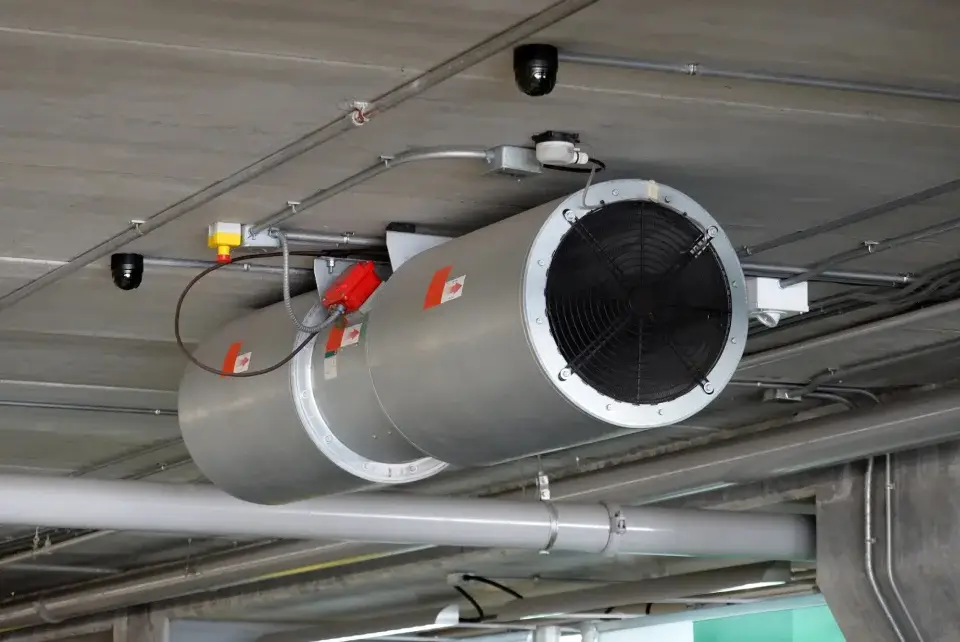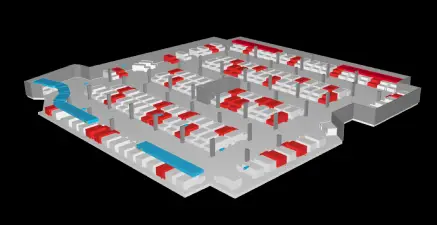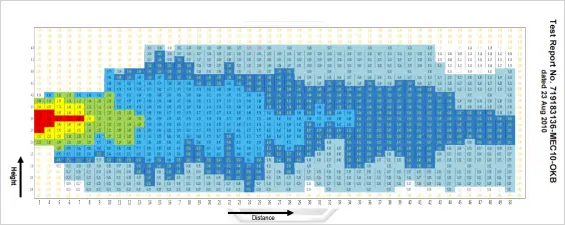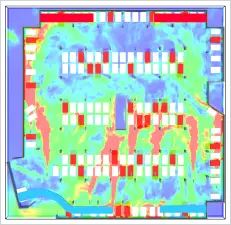The Problem with Traditional Ducted Systems
Traditional ducted ventilation systems are no longer the most effective option for modern car park design. While widely used in the past, they come with significant drawbacks that impact both construction and long-term performance.
Common issues with ducted systems include:
Takes up valuable ceiling space, limiting headroom and affecting lighting, sprinkler layout, and aesthetics.
Higher installation and material costs, due to extensive ductwork, supports, and coordination.
Reduced energy efficiency, caused by pressure losses within the duct network, leads to higher fan power consumption.
Difficult installation, especially in complex car park layouts with multiple beams, pipes, and structural obstacles.
Our services
What is a Ductless Jet Fan System?
A ductless jet fan system is an engineered smoke purging solution for car parks, designed to improve firefighter safety and compartmentalize smoke zones effectively.
Core features include:
Smoke control zones ≤ 2,000 m²: Car parks are divided into virtual or physical zones, each not exceeding 2,000 m² (excluding circulation or plant areas) to contain smoke and facilitate quicker fire detection and response.
Automatic activation: Jet fans are triggered by the sprinkler system covering the basement car park level and adjacent zones.
Firefighter approach route: The system must maintain at least one viable approach route within 5 m of any potential fire location, with visibility ≥ 5 m at 1.7 m height and temperatures below 250 °C to ensure safe rescue and firefighting operations.
Why choose us
Why Choose a Ductless Jet Fan System?
A ductless jet fan system delivers smart, compliant car park ventilation with multiple advantages over traditional ducted solutions.
Maximise Headroom & Space
By removing ducts, jet fan systems use significantly less ceiling height, often gaining 0.5–0.75 m, making car parks more spacious and easier to coordinate with other ceiling services.
Reduce Costs
Installation is faster and simpler. Costs associated with material, duct supports, and complex routing are eliminated, making a ductless jet fan system typically cheaper than ducted systems.
Improve Energy Efficiency
Jet fans reduce energy usage by minimizing static pressure and using targeted activation via CO or smoke detectors. This control reduces running costs and noise while improving overall ventilation effectiveness.
Enhanced Safety & Performance
In fire events, a ductless jet fan system can contain smoke, maintain visibility, and ensure safe firefighter access, providing superior smoke control compared to rigid ducted systems.
Our Design & Simulation Process - From Concept to Compliant Design
Step 1: Initial Consultation & Feasibility
We begin by reviewing your architectural and mechanical and electrical (M&E) plans to understand the unique layout and ventilation challenges of your car park. This early-stage consultation helps us assess the feasibility of a ductless jet fan system and identify the optimal design strategy tailored to your space and usage.
Step 2: CFD Modelling
Next, we build a detailed 3D model using advanced CFD software. This simulation captures how air, CO, and smoke will behave within your car park under both normal and emergency scenarios. It ensures complete spatial coverage and helps us verify that the design meets performance benchmarks set by the Singapore Civil Defence Force (SCDF) and the Building and Construction Authority (BCA).
Step 3: System Optimization
We refine the ductless jet fan system model by adjusting fan placement, thrust levels, and activation sequences. The goal is to achieve maximum airflow efficiency and effective smoke purging while minimizing energy use and equipment costs.
Step 4: SCDF & BCA Submission Drawings
Once the ductless jet fan design is finalized, our Professional Engineers (PEs) prepare detailed submission drawings and calculation reports. These are fully endorsed to meet the requirements for approval by SCDF and BCA, ensuring a smooth regulatory pathway.

Why choose us
Why Soteria for Your Jet Fan Design?
In-House CFD Simulation Expertise
We don’t outsource critical analysis. Our PEs use advanced CFD software in-house to model airflow, smoke movement, and fan performance, delivering precision -optimized solutions.
Deep Knowledge of SCDF & BCA Ventilation Codes
Our team has hands-on experience with SCDF Fire Code, SS 553, and BCA submission protocols, ensuring your design meets every technical and regulatory requirement.
Led by Professional Engineers (PE)
All designs are reviewed and endorsed by registered PEs, giving your project the technical assurance and credibility required for smooth authority approval.
Integrated Fire Safety Approach
We design ductless car park ventilation systems with a full understanding of your building’s fire safety plan, aligning smoke control with evacuation, compartmentation, and detection strategies.
Compliance & Regulatory Credentials
Our ductless jet fan designs fully comply with the SCDF Fire Safety Requirements, including smoke purging acceptance criteria for car parks.
We also align with the BCA circular outlining the use of CFD simulations for the approval of Alternative Solutions, specifically, jet fan systems as a replacement for traditional ducted ventilation.
Every design is validated and endorsed by a registered PE, ensuring technical soundness and regulatory integrity. By working with Soteria, you gain a partner that simplifies compliance while delivering ventilation systems ready for submission and approval.
gallery
Case Studies & Project Highlights



Frequently Asked Questions About Ductless Jet Fan Systems
What are ducts vs jet fan systems?
Ducted systems rely on enclosed sheet‑metal duct networks to transport air, while ductless jet fan systems use high-velocity fans strategically placed to induce airflow directly through open car park spaces.
When is CFD simulation required?
BCA require CFD modelling for car parks when proposing jet fans as an Alternative Solution per SS 553. SCDF requires modelling when the solution exceeds the prescriptive code requirements of the Fire Code.
What are the activation requirements for ductless jet fan systems?
Jet fan systems must activate automatically via the sprinkler system serving the car park level and adjacent zones. Alternatively, activation may be via smoke detectors only if two detectors activate, positioned at mid‑range of the jet fan profile or in‑duct at the exhaust start. A manual firefighter cut‑off/override switch is required at the Fire Command Centre.
Jets fans are also activated by Carbon Monoxide sensors placed strategically in the car park.
How do I submit a ductless jet fan design to BCA?
To submit a ductless jet fan system as an Alternative Solution, a PE must conduct CFD simulations and prepare a report following the BCA/. The submission, sent to the Commissioner of Building Control, must justify compliance in lieu of traditional ductwork.
What spacing and airflow criteria must be met for ductless jet fan systems?
Ductless jet fans must be spaced at no more than two‑thirds of their tested effective range (to the point where air velocity drops to 0.2 m/s). Design must ensure the induced bulk air velocity is sufficient to stop the ceiling-jet within 5 m of a fire and maintain at least one viable firefighter approach route. No stagnant areas are allowed, and overall airflow must not exceed what is extracted by the main exhaust fans.
GET IN TOUCH
Request Jet Fan Design Consultation
Address
Soteria Pte. Ltd.
7 Gambas Crescent #04-15
Ark@Gambas, Singapore 757087
Phone:
HP: +65 8786 1995
Email:
Working Hours:
Mon – Fri 0900 – 1800 hrs